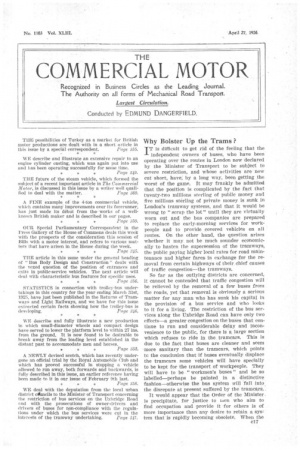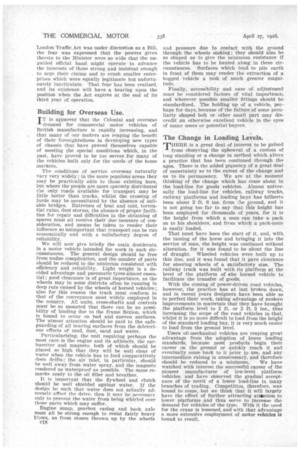Why Bolster Up the Trams ?
Page 1

Page 2

If you've noticed an error in this article please click here to report it so we can fix it.
IT is difficult to get rid of the feeling that the independent owners of buses, who have been operating over the routes in London now declared by the Minister of Transport to be subject to severe restriction, and whose activities are now cut short, have, by a long way, been getting the worst of the game. It may frankly be admitted that the position is complicated by the fa_ct that twenty-two millions sterling of public money and five millions sterling of private money is sunk in London's tramway systems, and that it would be wrong tp "scrap the lot" until they are virtually worn out and the bus companies are prepared to replace the early-morning services for workpeople and to provide covered vehicles on all routes. On the other hand, the question arises whether it may not be much sounder economically to hasten the supersession of the tramways, the public paying higher local rates for road maintenance and higher fares in exchange for the removal from certain highways of their chief causes of traffic congestion—the tramways.
So far as the outlying districts are concerned, it cannot be contended that traffic congestion will be relieved by the removal of a few buses from the roads, yet that removal is obviously a serious matter for any man who has sunk his capital in the provision of a bus service and who looks to it for a living. The restriction of the bus services along the Uxbridge Road can have only two effects—a greater congestion on the buses that continue to run and considerable delay and inconvenience to the public, for there is a large section which refuses to ride in the tramcars. This is due to the fact that buses are cleaner and seem more sanitary than the tramcars, which points to the conclusion that if buses eventually displace the tramcars some vehicles will have specially to be kept for the transport of workpeople. They will have to be " workmen's buses" and be so labelled—perhaps be painted. in a distinctive fashion—otherwise the bus system will fall into the disrepute at present suffered by the tramcars.
It would appear that the Order of the Minister, is precipitate, for justice to wen who aim to find occupation and provide it for others is of more importance than any desire to retain a sys: tern that is rapidly becoming obsolete. When the London Traffic Act was under discussion as a Bill, the fear was expressed that the powers given therein to the Minister were so wide that the unguided official hand might operate to advance the interests of those strong and insistent enough to urge their claims and to crush smaller enterprises which were equally legitimate but unfortunately inarticulate. That fear has been realized, and its existence will have a bearing upon the position when the Act expires at the end of its third year of operation.
Building for Overseas Use.
TT is apparent that the Colonial and overseas demand for commercial motor vehicles of British manufacture is rapidly increasing, and that many of our makers are reaping the benefit of their -foresightedness in developing new types of chassis that have proved themselves capable of meeting the special conditions which, in the past, have proved to be too severe for many of the vehicles built only for the needs of the home markets.
The conditions of service overseas naturally vary very widely ; in the more populous areas they may be practically akin to those existing here, but where the people are more sparsely distributed the only roads available for transport may be little better than tracks, whilst the crossing of fords may be necessitated by the absence of suitable bridges. Extremes of heat and cold, torrential rains, dust storms, the absence of proper facilities for repair and difficulties in the obtaining of spares must all receive their due measure of consideration, and means be taken to render their influence so unimportant that transport can be run economically and with a satisfactory degree of reliability.
We will now give briefly the main desiderata in a motor vehicle intended for work in such circumstances. The general design should be free from undue complication, and the number of parts should be reduced to the minimum consistent with efficiency and reliability. Light weight is a decided advantage and pneumatic tyres almost essential; good clearance is of great importance, as the wheels may in some districts often be running in deep ruts caused by the wheels of horsed vehicles ; also for this reason the track must conform to that of the conveyance most widely employed in the country. All units, cross-shafts and controls must be so mounted that there can be no possibility of binding due to the frame flexion, which is bound to occur on bad and uneven surfaces. The utmost attention should be paid to the safeguarding of all hearing surfaces from the deleterious effects of mud, dust, sand and water: Particularizing, the unit requiring perhaps the most care is the engine and its adjuncts, the carburetter and magneto, both of which should be placed so high that they will be well clear of water when the vehicle has to ford comparatively deen drifts ; the air inlet, in particular, should be well away from water spray, and the magneto rendered as waterproof as possible. The same remarks apply to the oil filler and breather.
It is important that the flywheel and clutch should be well shielded against water. If the design be such that water does not actually adversely affect the drive, then it may be necessary only to prevent the water from being whirled over those parts which may suffer.
Engine sump, gearbox casing and back axle must all be strong enough to resist fairly heavy blows, as from stones thrown up by the wheels e18 and pressure due to contact with the ground through the wheels sinking; they should also be so shaped as to give the minimum resistance if the vehicle has to be hauled along in these circumstances. Surfaces which tend to pile earth in front of them may render the extraction of a bogged vehicle a task of much greater magnitude.
Finally, accessibility and ease of adjustment must be considered factors of vital importance, and wherever possible smaller fittings should be standardized. The holding up of a vehicle, perhaps for days, because of the failure of some peculiarly shaped bolt or other small part may discredit an otherwise excellent vehicle in the eyes of many users or potential buyers.
The Change in Loading Levels.
THERE is a great deal of interest to be gained from observing the upheaval of a custom of long standing or a change in method which alters a practice that has been continued through the ages. There is the added piquancy of a great deal of uncertainty as to the extent of the change and as to its permanency. We are at the moment thinking of the change which has come about in the load-line for goods vehicles. Almost universally the load-line for vehicles, railway trucks, railway platforms and loading bays has hitherto been about 3 ft. 6 ins. from the ground, and it is not going too far to say that this height has been employed for thousands of years, for it is the height from which a man can take a pack on to his shoulders, and from which a pack-mule is easily loaded.
That must have been the start of it. and, with the taming of the horse and bringing it into the service of man, the height was continued without alteration, for it was found to be about the line of draught. Wheeled vehicles were built up to this line, and it was found that it gave clearance for steering wheels of a satisfactory size. The railway truck was built with its platform at the level of the platform of gthe horsed vehicle to facilitate the transfer of goods.
With the coming of power-driven road vehicles, however, the practice has at last broken down, and in recent years designers have been able so to perfect their work, taking advantage of modern improvements in materials that they have brought the platform level to 2 ft. or 2 ft. 3 ins., thus increasing the scope of the road vehicles in that, whilst it is no more difficult to load from the height of the standard loading bay, it is very much easier to load from the ground level.
Users of. mechanical vehicles are reaping great advantage from the adoption of lower loading standards, because most products begin their career on the ground or quickly reach it and eventually come back to it prior to use, and any intermediate raising is unnecessary, and therefore should be reduced to a minimum. We have watched with interest the successful career of the pioneer manufacturer of low-level platform vehicles, and have observed the gradual acceptance of the merit of a lower load-line in many branches of trading. Competition, therefore, was bound to come, but we think that it will largely have the effect of further attracting attention to lower platforms and thus serve to increase the demand for vehicles of the type. With it the need for the crane is lessened, and with that advantage a more extensive employment of motor vehicles is bound to result.
































